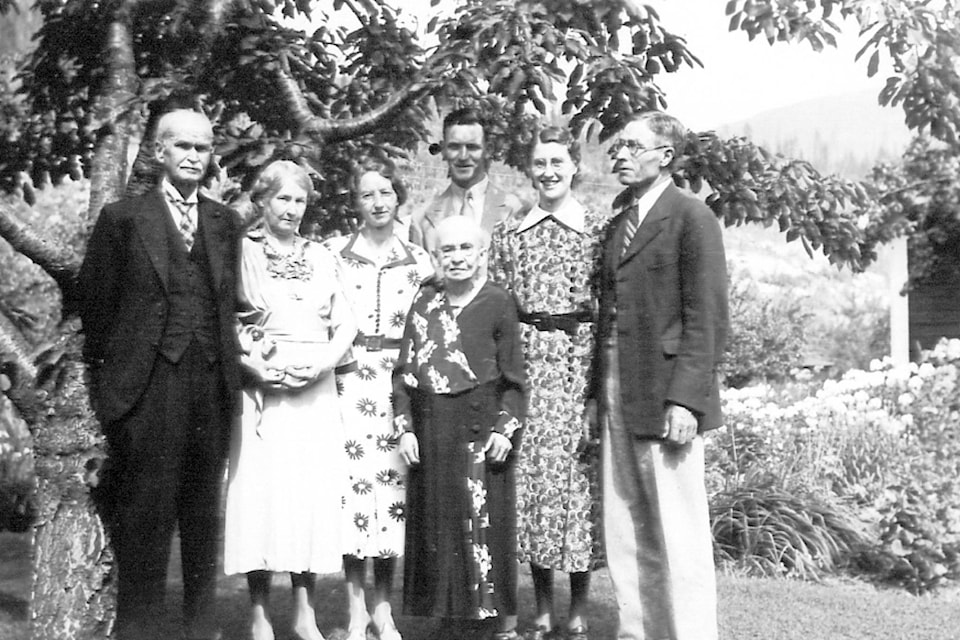As the optimism of the 1920s was washed away by the Depression, McDairmid &Squires decided to advertise for an operations manager who would have a formal background in horticulture.
Such a move would add a sounder scientific basis to their enterprise and improve stock selection and marketing techniques. They selected an applicant with a strong connection to Britain.
Duncan Henry Carter pursued his horticulture studies in Surrey, U.K. It is not clear whether he was already in Canada when he replied to the advertisement, but he arrived in Nelson in March of 1931.
Eleanor Carter was at the station with her parents to pick Duncan up. As she would relate later, when he was stepping off the train, a flame was kindled, and she knew that he was the man she would share the remainder of her life with. Somewhat to the consternation of her parents, a rapid courtship followed and the couple were married on June 21 of that year.
Their honeymoon to Banff was put to good use. As they explored the countryside they took note of the various alpine plants which could be useful to add another dimension to the Riverview holdings.
Basic stocks for propagation were collected and brought home. The sign at the entrance to Riverview could now advertise: HARDY PERENNIALS, ROCK PLANTS, CUT FLOWERS, FRUIT. Their catalogue now also included Alpine Plants amongst the several hundred plant varieties listed.
Duncan’s search for suitable alpine plants continued, in the company of his wife or with like-minded friends. Alpine areas in the vicinity of New Denver and in Kokanee Glacier Park were explored and samples were collected for trials at lower altitudes.
Eventually he may have had misgivings about such harvesting of native plants as he initiated a correspondence with the Society for the Preservation of Native Plants of BC, whose opinion was that collecting should not be allowed in parks, nor along highway shoulders. Duncan also expanded plant stocks by seed exchanges with other B.C. horticulturalists and with similar interests in England. Letters document his numerous contacts with whom he sought to forge personal linkages through exchange visits. Other letters also document unforeseen problems, such as plant injury from Cominco smelter fumes.
These stocks were grown all over the property in rock gardens and fields so that visiting customers could appreciate what could be accomplished.
A six-sided gazebo had been constructed on a point overlooking the entrance driveway. Behind it was located a sunken patio with a rock fountain; a large slab of stone was fashioned into an appropriate nearby bench. Rock gardens provided the borders and flowed over the embankments; everything seemed to be afloat in a field of chrysanthemums. These were another Riverview specialty offered in 19 varieties as cut flowers at $1.50 per dozen.
Duncan was the local representative of the Farmers Institute of BC, and in 1935 he approached the provincial Department of Agriculture if they could send a trained representative on a visitation circuit of some 200 branches. His suggestion was adopted.
In the summer of 1935 Eleanor was overtaken by an illness characterized by fevers; much to Duncan’s relief she recovered later that year.
Two years later they started planning a trip to England, which they took in the winter of 1938. Although the unspecified reason for going was a sad one (likely the death of his mother), Duncan enjoyed showing Eleanor his homeland. A visit to Kew Gardens was a highlight.
As the world spun towards another devastating war the Robson agricultural community faced problems of its own. On October 27, 1939 the Robson Cooperative Exchange packing and shipping warehouse burnt down. The fire was started early in the morning by an overheated stove in the closed secretary’s office that was not yet occupied; by the time it was observed it was too late to extinguish it.
The fire was entirely accidental. The building was rebuilt, only to be lost to fire again, this time to arson. It was rebuilt once again, this time across the road from the original site near the wharf. The masonry block building is still in place.
The fruit industry was now threatened by new challenges. The province established a single marketing association, whose inflexibility favoured the Okanagan growers. Other factors that reduced profitability included a weakening of the transportation system and the introduction of new pests. The war would add additional complications by removing the manpower, although locally Doukhobor men and women were available to help out.
The boom times were over.
